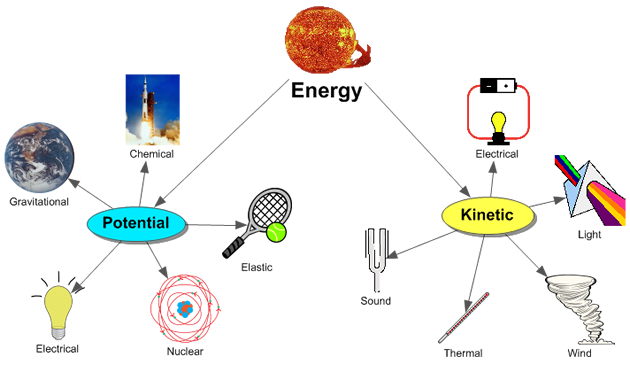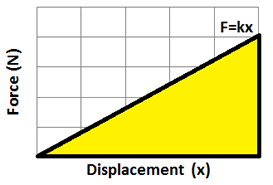Tag Archives: energy
Intro to Energy
Types of Energy
We’ve all had days where we’ve had varying amounts of energy. You’ve gotten up in the morning, had to drag yourself out of bed, force yourself to get ready to school, and once you finally get to class, you don’t have the energy to do much work. Other days, when you’ve had more energy, you may have woken up before the alarm clock, hustled to get ready for the day while a bunch of thoughts jump around in your head, and hurried on to begin your activities. Then, throughout the day, the more work you do, the more energy you lose… What’s the difference in these days?
In physics, energy is the ability or capacity to do work. And as we’ve mentioned previously, work is the process of moving an object. So, if we combine our definitions, energy is the ability or capacity to move an object. And so far this year we’ve been studying kinetic energy, or energy of motion. So… kinetic energy must be the ability or capacity of a moving object to move another object!
Mathematically, kinetic energy is calculated using the formula:
![]()
Units of energy are the same as units of work, the joule (J). By dimensional analysis, we can observe that the units of KE (kg*m2/s2) must be equal to the units of work (N*m):
![]()
Of course, there are more types of energy than just kinetic. Energy comes in a tremendous variety of forms, which we can classify as kinetic (energy of motion) or potential (stored) to various degrees: solar energy, thermal energy, gravitational potential energy, nuclear energy, chemical potential energy, sound energy, electrical energy, elastic potential energy, light energy, and so on. In all cases, energy can be transformed from one type to another, and you can transfer energy from one object to another by doing work.

Gravitational Potential Energy
Potential energy is energy an object possesses due to its position or condition. Gravitational potential energy, then, is the energy an object possesses because of its position in a gravitational field (height).
Let’s assume we have a 10 kg box on the floor. Let’s arbitrarily call its current potential energy zero, just to give us a reference point. If we do work to lift the box one meter off the floor, we need to overcome the force of gravity on the box (its weight) over a distance of one meter. Therefore, the work we do on the box can be obtained from:
![]()
So, to raise the box to a height of 1m, the must do 98.1 Joules of work on the box. The work done in lifting the box is equal to the change in potential energy of the box, so the box’s gravitational potential energy must be 98.1J.
When we performed work on the box, we transferred some of our stored energy to the box. Along the way, it just so happens that we derived the formula for the gravitational potential energy of an object. The change in the object’s potential energy, ![]() PE, is equal to the force of gravity on the box multiplied by its change in height, mg
PE, is equal to the force of gravity on the box multiplied by its change in height, mg![]() h. This formula can be found on the reference table:
h. This formula can be found on the reference table:
![]()
Elastic Potential Energy
Another form of potential energy involves the stored energy an object possesses due to its position in a stressed elastic system. An object at the end of a compressed spring, for example, has elastic potential energy. When the spring is released, the elastic potential energy of the spring will do work on the object, moving the object and transferring the energy of the spring into kinetic energy of the object. Other examples of elastic potential energy include tennis rackets, rubber bands, bows (as in bows and arrows), trampolines, bouncy balls, and even pole-vaulting poles.
The most common problems involving elastic potential energy in Regents Physics involve the energy stored in a spring. As we learned in the previous topic on work, the force needed to compress or stretch a spring from its equilibrium position increases linearly… the more you stretch or compress the spring, the more force it applies trying to restore itself to its equilibrium position. We called this Hooke’s Law:
![]()

Further, we can find the work done in compressing or stretching the spring by taking the area under a Force vs. Displacement graph for the spring.
![]()
Since the work done in compressing or stretching the spring from its equilibrium position transfers energy to the spring, we can conclude that the potential energy stored in the spring must be equal to the work done to compress the spring, therefore we can write:
![]()
Work-Energy Theorem
Of course, there are many, many different kinds of energy which we haven’t mentioned specifically. And energy can be converted among its many different forms, such as mechanical (which is kinetic, gravitational potential, and elastic potential), electromagnetic, nuclear, and thermal (or internal) energy.
When a force does work on a system, the work done changes the system’s energy. If the work done increases motion, there is an increase in the system’s kinetic energy. If the work done increases the object’s height, there is an increase in the system’s gravitational potential energy. If the work done compresses a spring, there is an increase in the system’s elastic potential energy. If the work is done against friction, however, where does the energy go? In this case, the energy isn’t lost, but instead increases the rate at which molecules in the object vibrate, increasing the object’s temperature, or internal energy.
The understanding that the work done on a system by an external force changes the energy of the system is known as the Work-Energy Theorem. If an external force does positive work on the system, the system’s total energy increases. If, instead, the system does work, the system’s total energy decreases. Put another way, you add energy to a system by doing work on it, and take energy from a system when the system does the work (much like you add value to your bank account by making a deposit, and take value from your account by writing a check).
This relationship is documented on the Regents Physics Reference Table by showing the formula for work as equal to the force times the displacement (F*d), as well as the change in total energy (![]() E):
E): ![]() .
.
Sources of Energy on Earth

So where does all this energy initially come from? Here on Earth, the energy we deal with everyday ultimately comes from the sun. The sun’s radiation provides an energy source for live on earth, which over the millenia has become the source of our fossil fuels. The sun’s radiation also provides the thermal and light energy that heat the atmosphere and cause the winds to blow. The sun’s energy evaporates water, which eventually recondenses as rain and snow, falling to the Earth’s surface to create lakes and rivers, with gravitational potential energy, which we may harness in hydroelectric power plants. Just try to find an energy source on the Earth that doesn’t originate with the sun!
Intro to Work and Power
Defining Work
Sometimes we work hard. Sometimes we’re slackers. But, right now, are you doing work? And what do we mean by work?
Work — the process of moving an object by applying a force
In order for a force to qualify as having done work on an object, there must be a displacement and the force must cause the displacement.
I’m sure you can think up countless examples of work being done, but a few that spring to my mind include pushing a snowblower to clear the driveway, pulling a sled up a hill with a rope, stacking boxes of books from the floor onto a shelf, and throwing a baseball from the pitcher’s mound to home plate.
Let’s try an exercise: Which of the following are examples of work being done?

- Sandy struggles to push her stalled car, but can’t make it move.
- Jeeves the butler carries a tray above his head by one arm across the room at a constant velocity.
- A missile streaks through the upper atmosphere.
Each of these examples help us better understand the definition of work. In example 1, even though Sandy pushes her car, with all her might, the car doesn’t move, therefore no work is done.
Example 2 is a very tricky situation. In this scenario, Jeeves applies a force upward with his arm, but the tray moves horizontally. From this perspective, the force of the butler’s arm isn’t causing the displacement, therefore you could say no work is done by his arm. However, Jeeves’ legs are pushing him forward, and therefore the tray moves horizontally, so you could say from this perspective he is doing work on the tray. (In actuality, the situation is even more complex than this as we pull friction and normal forces into the equation, but for the sake of clarity, let’s move on…)

In example 3, the missile’s engines are applying a force causing it to move. But what is doing the work? The hot expanding gas is pushed backward out of the missile’s engine… so, using Newton’s 3rd Law, we observe the reactionary force of the gas pushing the missile forward, causing a displacement. Therefore, the expanding exhausted gas is doing work on the missile!
Calculating Work
Mathematically, work can be expressed by the following equation:
![]()
Where W is the work done, F is the force applied, in Newtons, and d is the object’s displacement, in meters.
The units of work can be found by a unit analysis of the work formula. If work is force multiplied by distance, the units must be the units of force multiplied by the units of distance, or newtons multiplied by meters. A newton-meter is also known as a Joule (J).

It’s important to note that when using this equation, only the force applied in the direction of the object’s displacement counts! This means that if the force and displacement vectors aren’t in exactly the same direction, you need to take the component of force in the direction of the object’s displacement. To do this, line up the force and displacement vectors tail-to-tail and measure the angle between them. Since this component of force can be calculated by multiplying the force times the cosine of the angle between the force and displacement vectors, we can re-write our work equation as:
![]()
Let’s examine a few more examples:
Question: An appliance salesman pushes a refrigerator 2 meters across the floor by applying a force of 200N. Find the work done.
Answer: Since the force and displacement are in the same direction, the angle between them is 0:
.
Question: A friend’s car is stuck on the ice. You push down on the car to provide more friction for the tires (by way of increasing the normal force), allowing the car’s tires to propel it forward 5m onto less slippery ground. How much work did you do?
Answer: You applied a downward force, yet the car’s displacement was sideways. Therefore, the angle between the force and displacement vectors is 90°, so:
.
Question: You push a crate up a ramp with a force of 10N. Despite your pushing, however, the crate slides down the ramp a distance of 4m. How much work did you do?
Answer: Since the direction of the force you applied is opposite the direction of the crate’s displacement, the angle between the two vectors is 180°.
Question: How much work is done in lifting an 8-kg box from the floor to a height of 2m above the floor?
Answer: It’s easy to see the displacement is 2m, and the force must be applied in the direction of the displacement, but what is the force? To lift the box we must match and overcome the force of gravity on the box. Therefore, the force we must apply is equal to the gravitational force, or weight, of the box:

Question:Barry, John, and Sidney pull a 30-kg wagon with a force of 500N a distance of 20m. The force acts at a 30° angle to the horizontal. Calculate the work done.
Answer:
Force vs. Displacement Graphs

The area under a force vs. displacement graph is the work done by the force. Consider the situation of a block being pulled across a table with a constant force of 5 Newtons over a displacement of 5 meters, then the force gradually tapers off over the next 5 meters.
The work done by the force moving the block can be calculated by taking the area under the force vs. displacement graph (a combination of a rectangle and triangle) as follows:









